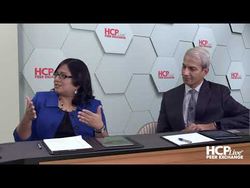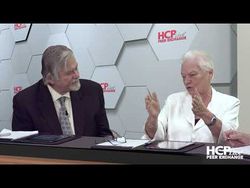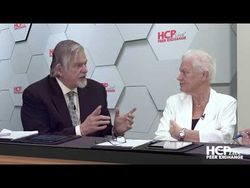Management of Beta Thalassemia - Episode 8
Iron Dysregulation & Allogeneic Stem Cell Transplantation
Peter L. Salgo, MD: Let me touch on something in the time we have left just for a moment. We’ve all been talking about iron-management strategies. To me that means mostly chelation. I’ve heard that word a few times. Lead me down that path a little—who gets chelated? How do you do it? What are the risks with that?
Sujit Sheth, MD: The problem with the human body is that it has no way of excluding excess amounts of iron. It accumulates and it stores. If you went out at lunchtime and had 2 bags of potato chips, your sodium level will not go up very much because your kidneys will pee the extra sodium out. If you got transfused with red blood cells, the iron that goes in there stays in there and has to be helped to be treated. Your body has to get the systems to excrete that iron because you lose very small amounts of iron on a daily basis through shedding of epithelium mostly.
Once you get to the point where you are filling up your liver, your liver is the normal storage site for iron. And as you fill up your liver, that iron can then spill out and go to other organs, particularly the heart and the endocrine organs, and then can cause significant complications there. You want to prevent that from happening. Typically after about 1 year to 15 months of regular transfusions, we will start somebody on regular iron chelation.
Peter L. Salgo, MD: How often is regular?
Sujit Sheth, MD: Daily.
Peter L. Salgo, MD: Daily.
Sujit Sheth, MD: Yes. The good thing is now we have oral chelators.
Peter L. Salgo, MD: That’s where I was going.
Sujit Sheth, MD: They take it once a day, in the morning or at night, and you just keep taking that every single day. And you can be kept in iron balance.
Peter L. Salgo, MD: And just so that we get the mechanism nailed down once. You take the chelator; it grabs iron and holds on to it. And where does it go?
Sujit Sheth, MD: It gets excreted. The different chelators get excreted different places. There are 3 chelators, the injectables are ones we talked about forever. Most of that gets excreted through the kidneys and it comes out of your urine. Now the urine looks like rust; essentially it looks red because it’s rusty. And then with once-a-day chelator, about 80% of it comes out through your bile. Your liver metabolizes it and then it gets excreted in your bile. And about 20% in your urine. And then the third chelator is about half and half.
Peter L. Salgo, MD: All right. Before we go on to our next big topic, you’ve all been alluding to this 1 way or another. To me, I think I hear you alluding to allogeneic stem cell transplantation. Is that where you’re going with that? Is that what I’m hearing?
Thomas D. Coates, MD: Yes.
Peter L. Salgo, MD: Tell me about that. How does it work? How is it circulated? Who gets it?
Thomas D. Coates, MD: Again, there’s probably a little bit of center-to-center variance in there. But at our center, if we have a newly diagnosed thalassemia major patient, transfusion is going to be transfusion dependent. And if they have a sibling who’s a perfect match and doesn’t have thalassemia itself, there’s a 1 of 4 chance that any 1 of your brothers or sisters by the same mother and father will be a match. We recommend bone marrow transplantation, usually after age 3 or maybe 2 or 3 when they’re physically big enough to make it easy.
Peter L. Salgo, MD: Very early.
Thomas D. Coates, MD: Very early. As early as possible. Often this discussion may go on for a while because there are some risks. But frankly, the technology of bone marrow transplant has improved dramatically. And that cures them of the disease.
Maria Domenica-Cappellini, MD: Going back to the history, the first bone marrow transplantation was performed in 1981. I remember fighting for this approach because the experts on treating thalassemia with standard transfusion and chelation were totally against it.
Peter L. Salgo, MD: Why would that be?
Maria Domenica-Cappellini, MD: Because at the beginning we lost, frankly speaking, many patients because of the approach of bone marrow transplantation, because they had to undergo conditioning with an important chemotherapy. So we had many patients who died, unfortunately, of the disease. There were really 2 schools of thought. Those saying that we have standardized a good treatment with transfusion and chelation, so we are keeping our patients living longer. Then, I have to say, this was a huge contribution of the Italian group who actually recommended that there is a condition of treatment. I should say that bone marrow transplantation is the only proved curative treatment.
Peter L. Salgo, MD: Let me go through, because I know many of the clinicians watching this have the same questions I do. I see bone marrow transplant patients, typically they’re adults because I treat now big people. They look dreadful, and the process is dreadful. Is it that bad for kids getting this? Is it the same?
Sujit Sheth, MD: There are several things to think about here. Thalassemia is no longer a lethal disease. It’s a very cumbersome disease. However, that cumbersome nature of the disease does impact quality of life quite significantly. And so if you have the availability of a cure, you should think about it very seriously. We recommend going to allogeneic stem cell transplant right now—at least I do—only if you have a matched sibling or matched related donor. Because the results from those kinds of transplants are now well in the 90% event-free survival and 97%, 98% overall survival.
Peter L. Salgo, MD: Immunosuppressive therapy going forward.
Sujit Sheth, MD: They get immune, so it’s not quite the same as solid organ transplant, where you have to be on lifelong immune therapy.
Peter L. Salgo, MD: Right, that’s what I was asking.
Sujit Sheth, MD: This is only about 6 months of immunosuppression after the transplant, and then you can come off it because you have a new immune system from your donor and it’s adopted here.
Peter L. Salgo, MD: Did I mention how happy I am to be at the same table with you guys. I mean this is all really good news.
Thomas D. Coates, MD: I have to say that—and I’m not a bone marrow transplanter—the technology, actually with sibling transplants, the mortality is very, very low. It’s obviously not 0, but I’ve had some heads of major programs say, “Gee, we haven’t lost a patient,” and they can’t remember when.
Peter L. Salgo, MD: Right.
Thomas D. Coates, MD: They do very well. But what’s also happened is all this technology has been growing amazingly fast in the last decade. They can now do tissue matching by DNA and get very accurate matching. And the data suggest that if you have a 10 of 10 or better unrelated match, the prognosis there is also very good and so supposedly very similar. In the last maybe 5 years, we’ve actually been referring patients for unrelated donor transplantation as well. And the outcomes there are reasonably good as well.
But 1 of the problems, if you want to call it that, with thalassemia, is there is risk to bone marrow transplant. We have an alternative therapy that we know we can manage very well: transfusion and chelation. It’s not unlike the tumor patients who you’re talking about where, if you don’t treat them, they’re not going to survive. That means that these discussions with the family sometimes go on for a couple of years.
Transcript edited for clarity.



